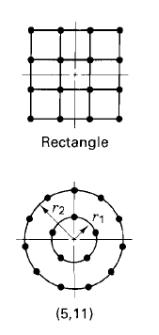lomaxe
Member level 1
Hi everybody!
Can somebody help me in understanding some things?
The two constellations are given: square constellation 4x4 (M=16) and circular (5,11) constellation, as shown at the figure below:

The question: Why might the square constellation be more practical?
The answer: The square constellation requires only two amplitudes and two orthogonal phases, whereas the circular constellation requires either two amplitudes and 15 or 16 phases, or numerous amplitudes with two orthogonal phases.
Can somebody explain me the answer? I see three amplitudes for square constellation. And what do they mean under "two orthogonal phases"?
Can somebody help me in understanding some things?
The two constellations are given: square constellation 4x4 (M=16) and circular (5,11) constellation, as shown at the figure below:

The question: Why might the square constellation be more practical?
The answer: The square constellation requires only two amplitudes and two orthogonal phases, whereas the circular constellation requires either two amplitudes and 15 or 16 phases, or numerous amplitudes with two orthogonal phases.
Can somebody explain me the answer? I see three amplitudes for square constellation. And what do they mean under "two orthogonal phases"?